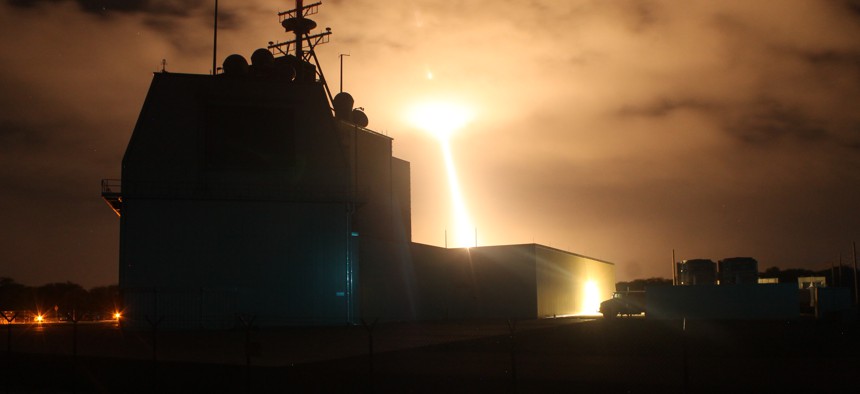
The Missile Defense Agency (MDA) and the Ballistic Missile Defense System (BMDS) Operational Test Agency, in conjunction with U.S. Pacific Command, U.S. European Command, and Joint Functional Component Command for Integrated Missile Defense, successfully Missile Defense Agency, Department of Defense
Improve Hawai’i’s Missile Defenses — Now
The islands need interceptor missiles to fend off possible attack from North Korea.
If North Korea’s Kim Jung-un decides to use his all-but-inevitable nuclear ICBM to strike the United States, his target might be Hawai’i. While the U.S. must continue to develop its continental anti-missile systems, it is past time to focus on improving the defenses of America’s 50th state.
Perhaps Pyongyang intends to use this capability as a bargaining chip, or a tool for continued provocation. But Hawai’i, isolated from the U.S. mainland and less well defended against ballistic missiles, might also be the ideal target for an actual DPRK attack. North Korean leaders may think it is the one strike they might get away with while dealing the hated Americans a crippling military and psychological blow. Russian or Chinese leaders in the right set of bad circumstances could reach the same conclusion.
For the people of Hawai’i, their elected representatives, and the military commands charged with defense of the state, there are several interconnected implications. The Hawai’i Emergency Management Agency, or HEMA, is commencing an effort to prepare residents and visitors for a potential nuclear missile attack from North Korea. But this has drawn fire from critics who call the program unnecessary and a threat to Hawai’i’s island-paradise image.
Hawai’i’s Congressional representatives have expressed confidence in the existing U.S. missile defense system, whose interceptors are based in California and Alaska, and touted a long-term effort to bring an advanced missile-tracking radar to the state. But U.S. Pacific Command boss Adm. Harry Harris Jr. told lawmakers in April to consider nearer-term measures. Harris said the existing system could be “overwhelmed” by an ICBM attack. If that happened, he said, “someone would have to make a decision about which ones to take out or not.”
Related: Hawaii Needs Better Missile Defense Radars, Pacific Commander Says
Also Read: Hawaii’s Renewed Jitters About Nukes
The urgency is underscored by the July 29 launch of a second North Korean ICBM that was apparently more capable than the first one, launched just last month. Time is not on Hawai’i’s side. Immediate action is required to improve island defenses and readiness, and establish a credible deterrent. HEMA’s program is a must, even if it ruffles tourist boards' feathers. Continued development and testing of the continental U.S.-based defense system is also necessary. But the Hawai’i-specific defensive efforts are as, if not more, important.
An amendment to the 2018 National Defense Authorization Act has been introduced by U.S. Rep. Colleen Hanabusa. It requires the defense secretary to protect the missile test, training and evaluation operations of the Pacific Missile Range Facility, or PMRF, and assess Homeland Discrimination Radar-Hawaii (HDR-H). PMRF is the largest such range in the world, used for tests and exercises from small-scale to large, multi-battle group engagements. The new radar will improve the U.S. ability to track incoming missiles in the midflight over the Pacific, but won’t be operational until 2023 at the earliest. The amendment also directs the Missile Defense Agency to test and evaluate the capability of the new SM-3 Block IIA missile to hit an ICBM, but only after addressing PMRF and the radar. The stated rationale is that this amendment is a logical, sequenced approach to missile defense of the United States.
Insistence on maintaining the test capability of the PMRF, which is essential to missile-defense development, is laudable, and interest in ensuring the viability of the HDR-H is understandable. However, neither will address the urgent need to improve our defenses to counter a near-term attack.
Missile defense capability for Hawai’i must be pursued on a pace equal to or beyond Kim Jong-un’s missile program. North Korea is not doing more-of-the-same, and we cannot continue in a business-as-usual manner. The assessments mentioned in the NDAA must be accomplished aggressively, ideally inside the allowed timelines. Once complete, pursuit of near-term improvements is imperative. In particular, using the Aegis Ashore sensors at PMRF for operational surveillance in addition to the current test activity would be an important step in defending Hawai’i. An effort to team up Aegis Ashore with sufficient SM-3 interceptors, and possible the Terminal High Altitude Area Defense (THAAD) system, must be pursued. These near-term solutions are available, and while likely not perfect, can provide both capability and deterrence on a pace to match North Korea’s development program.
When Hawai’i’s elected representatives return home for the August recess, they no doubt will hear a lot about this from their constituents. They should reassure the voters by pledging to see their sequenced plan executed quickly, and promise to advocate near-term defensive options.
NEXT STORY: What’s Left to Sanction in North Korea?




